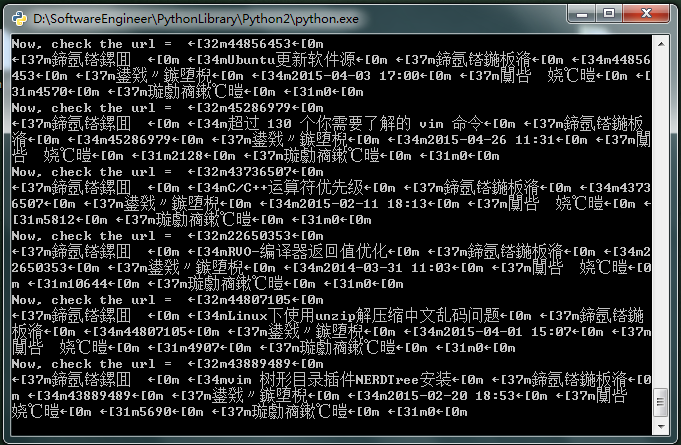分享一下我老师大神的人工智能教程!零基础,通俗易懂!http://blog.csdn.net/jiangjunshow
也欢迎大家转载本篇文章。分享知识,造福人民,实现我们中华民族伟大复兴!
问题提出
近期把一个Python项目移到了Windows下运行,竟然中文乱码了,在Linux上运行明明好好的。
呵呵,对Windows妥妥的没有爱了。。。。
问题原因
Python程序在Windows终端(cmd)下乱码,是字符串编码的问题
Python文件编码
Python 默认脚本文件都是 ANSCII 编码的,当文件 中有非 ANSCII 编码范围内的字符的时候就要使用”编码指示”来修正。 一个module的定义中,如果.py文件中包含中文字符(严格的说是含有非anscii字符),则需要在第一行或第二行指定编码声明:
# -*- coding=utf-8 -*-
- 1
或者
#coding=utf-8
- 1
其他的编码如:gbk、gb2312也可以; 否则会出现类似
SyntaxError: Non-ASCII character '/xe4' in file ChineseTest.py on line 1, but no encoding declared; see http://www.python.org/peps/pep-0263.html for details
- 1
这样的异常信息
实际上Python只检查#、coding和编码字符串,其他的字符都是为了美观加上的。另外,Python中可用的字符编码有很多,并且还有许多别名,还不区分大小写,比如UTF-8可以写成u8。参见http://docs.python.org/library/codecs.html#standard-encodings。
另外需要注意的是声明的编码必须与文件实际保存时用的编码一致,否则很大几率会出现代码解析异常。现在的IDE一般会自动处理这种情况,改变声明后同时换成声明的编码保存,但文本编辑器控们需要小心 :)
系统默认的编码方式可以采用:
import sysprint sys.getdefaultencoding( )
- 1
- 2
当然设置默认的编码方式采用:
import sysreload(sys)print sys.setdefaultencoding('utf-8')
- 1
- 2
- 3
至于为什么要reload sys,是因为系统在加载时删除了sys.setdefaultencoding(’utf-8’)这句,所以这个时候要重新加载reload sys模块才能调用sys.setdefaultencoding(’utf-8’)语句起作用
基础就这么多了,接下来我们再看看字符串的编码。。。。
str和unicode编码
str和unicode都是basestring的子类。严格意义上说,str其实是字节串,它是unicode经过编码后的字节组成的序列。
str类型是一个包含Characters represent (at least) 8-bit bytes的序列;unicode的每个unit是一个unicode obj
所以:len(u’中国’)的值是2;len(‘ab’)的值也是2;
在str的文档中有这样的一句话:The string data type is also used to represent arrays of bytes, e.g., to hold data read from a file. 也就是说在读取一个文件的内容,或者从网络上读取到内容时,保持的对象为str类型;如果想把一个str转换成特定编码类型,需要把str转为Unicode,然后从unicode转为特定的编码类型如:utf-8、gb2312等;
对UTF-8编码的str’汉’使用len()函数时,结果是3,因为实际上,UTF-8编码的’汉’ == ‘\xE6\xB1\x89’。
unicode才是真正意义上的字符串,对字节串str使用正确的字符编码进行解码后获得,并且len(u’汉’) == 1。
例如下面的代码
#coding=utf-8import sysif __name__ == "__main__" print sys.getdefaultencoding( ) # 默认编码为ascii s1 = '中文' print type(s1) # str[UTF-8编码] print len(s1) # 6 print s1 # 乱码 s2 = u'中文' # unicode print type(s2) # 2 print len(s2) # print s2 # 异常,UnicodeEncodeError: 'ascii' codec can't encode characters in position 0-1: ordinal not in range(128) # s2的编码为unicode,而当前文件的编码为utf-8,Python内置默认编码为ascii
- 1
- 2
- 3
- 4
- 5
- 6
- 7
- 8
- 9
- 10
- 11
- 12
- 13
- 14
- 15
- 16
再来看看encode()和decode()两个basestring的实例方法,理解了str和unicode的区别后,这两个方法就不会再混淆了:
encode和decode
首先,现存有很多种编码方式,就中文而言,gb2312,GBK,gb18030(包含中文字符最多最全面的)
而目前国际上常用的编码方式有:utf-8.(发现中文乱码之后,百度答案:在py文件开头添加coding为utf-8)
-*- conding: utf-8 -*- xxx.decode() 是把xxx按括号中的编码方式 解码成unicode xxx.encode() 是把unicode类型的xxx按括号中的编码方式 进行编码(所
- 1
- 2
- 3
以如果xxx不是unicode,系统会采用默认编解码方式对xxx进行解码,然后再做如上的编码操作)
下面我们看几个转换编码的例子
unicode转为 gb2312,utf-8等
#coding=utf-8#unicode转为 gb2312,utf-8等if __name__ == "__main__": s = u'中国' s_gb = s.encode('gb2312') print s_gb # utf-8,GBK转换为unicode 使用函数unicode(s,encoding) 或者s.decode(encoding) s = u'中国' #s为unicode先转为utf-8 s_utf8 = s.encode('UTF-8') assert(s_utf8.decode('utf-8') == s) print s_utf8.decode('utf-8')
- 1
- 2
- 3
- 4
- 5
- 6
- 7
- 8
- 9
- 10
- 11
- 12
- 13
- 14
- 15
普通的str转为unicode
#coding=utf-8import sys# 普通的str转为unicodeif __name__ == '__main__': # 如果把下面几行注视掉会异常 print sys.getdefaultencoding( ) reload(sys) sys.setdefaultencoding( "utf-8" ) print sys.getdefaultencoding( ) s = '中国' su = u'中国' print s # 乱码 print su # 不乱码 #s为unicode先转为utf-8 # 因为s为所在的.py(# -*- coding=UTF-8 -*-)文件编码应该为utf-8 # 采用sys.setdefaultencoding( "utf-8" )设置字符编码为utf-8 s_unicode = s.decode('UTF-8') assert(s_unicode == su) print s_unicode #s转为gb2312, 需要先转为unicode再转为gb2312 print s.decode('utf-8').encode('gb2312') #如果直接执行s.encode('gb2312')会发生什么? print s.encode('gb2312')
- 1
- 2
- 3
- 4
- 5
- 6
- 7
- 8
- 9
- 10
- 11
- 12
- 13
- 14
- 15
- 16
- 17
- 18
- 19
- 20
- 21
- 22
- 23
- 24
- 25
- 26
- 27
- 28
- 29
- 30
- 31
- 32
- 33
对比
#coding=utf-8import sysif __name__ == '__main__': s = '中国' print s #如果直接执行s.encode('gb2312')会发生什么? print s.encode('gb2312')
- 1
- 2
- 3
- 4
- 5
- 6
- 7
- 8
- 9
这里会发生一个异常:
UnicodeDecodeError: 'ascii' codec can't decode byte 0xe4 in position 0: ordinal not in range(128)
- 1
Python 会自动的先将 s 解码为 unicode ,然后再编码成 gb2312。因为解码是python自动进行的,我们没有指明解码方式,python 就会使用 sys.defaultencoding 指明的方式来解码。很多情况下 sys.defaultencoding 是 ANSCII,如果 s 不是这个类型就会出错。
拿上面的情况来说,我的 sys.defaultencoding 是 anscii,而 s 的编码方式和文件的编码方式一致,是 utf8 的,所以出错了: UnicodeDecodeError: ‘ascii’ codec can’t decode byte 0xe4 in position 0: ordinal not in range(128)
对于这种情况,我们有两种方法来改正错误:
一是明确的指示出 s 的编码方式
#! /usr/bin/env python # -*- coding: utf-8 -*- s = '中文' s.decode('utf-8').encode('gb2312')
- 1
- 2
- 3
- 4
二是更改 sys.defaultencoding 为文件的编码方式
#coding=utf-8import sysif __name__ == '__main__': reload(sys) sys.setdefaultencoding( "utf-8" ) s = '中国' print s #如果直接执行s.encode('gb2312')会发生什么? print s.encode('gb2312')
- 1
- 2
- 3
- 4
- 5
- 6
- 7
- 8
- 9
- 10
- 11
- 12
Pyton内部编码
首先要搞清楚,字符串在Python内部的表示是unicode编码,因此,在做编码转换时,通常需要以unicode作为中间编码,即先将其他编码的字符串解码(decode)成unicode,再从unicode编码(encode)成另一种编码。
在某些IDE中,字符串的输出总是出现乱码,甚至错误,其实是由于IDE的结果输出控制台自身不能显示字符串的编码,而不是程序本身的问题。
#coding=utf-8import sys if __name__ == "__main__":# 该文件的编码必需与s.decode('utf8')指定的编码一致,不然会抛出解码异常信息,# 可以通过s.decode("gbk", "ignore")或s.decode("gbk", "replace")来解决。 print sys.getdefaultencoding( ) # 默认编码为ascii s = '中文' # 该文件的编码为UTF-8, 因此无异常 s.decode('utf8') # 将默认的unicode编码字符解码成utf8 print s # 异常UnicodeDecodeError: 'gbk' codec can't decode bytes in position 2-3: illegal multibyte sequence #s.decode('GBK') #把unicode类型串的s按括号中GBK的编码方式,编码成GBK #print s # 异常UnicodeDecodeError: 'ascii' codec can't decode byte 0xe4 in position 0: ordinal not in range(128) #s.encode('GBK') #print s s.decode('gbk', "ignore") # 将s按照gbk编码解码为utf8,忽略其中有异常的编码,仅显示有效的编码 print s s.decode('gbk', 'replace') # 替换其中异常的编码,这个相对来可能一眼就知道那些字符编码出问题了 print s
- 1
- 2
- 3
- 4
- 5
- 6
- 7
- 8
- 9
- 10
- 11
- 12
- 13
- 14
- 15
- 16
- 17
- 18
- 19
- 20
- 21
- 22
- 23
- 24
- 25
- 26
- 27
该文件的编码必需与s.decode(‘utf8’)指定的编码一致,不然会抛出解码异常信息
文件编码与print函数
建立一个文件test.txt,文件格式用ANSI,内容为:
abc中文
- 1
用如下python代码来读取
#coding=gbkprint open("Test.txt").read()
- 1
- 2
结果输出
abc中文
- 1
把文件格式改成UTF-8:
结果:
abc涓枃
- 1
显然,这里需要解码
# coding=gbkimport codecsprint open("Test.txt").read().decode("utf-8")
- 1
- 2
- 3
结果:
abc中文
- 1
上面的test.txt我是用Editplus来编辑的,但当我用Windows自带的记事本编辑并存成UTF-8格式时,
运行时报错:
Traceback (most recent call last): File "ChineseTest.py", line 3, in <module> print open("Test.txt").read().decode("utf-8")UnicodeEncodeError: 'gbk' codec can't encode character u'/ufeff' in position 0: illegal multibyte sequence
- 1
- 2
- 3
- 4
原来,某些软件,如notepad,在保存一个以UTF-8编码的文件时,会在文件开始的地方插入三个不可见的字符(0xEF 0xBB 0xBF,即BOM)。
因此我们在读取时需要自己去掉这些字符,python中的codecs module定义了这个常量:
# coding=gbkimport codecsdata = open("Test.txt").read()if data[:3] == codecs.BOM_UTF8: data = data[3:]print data.decode("utf-8")
- 1
- 2
- 3
- 4
- 5
- 6
结果:
abc中文
- 1
总结
Windows下终端输出中午的方法
明确的指示出 s 的编码方式下输出中文
#coding=utf-8import sysif __name__ == "__main__": #reload(sys) #sys.setdefaultencoding( "utf-8" ) # 下面两种代码等价 print "中文".decode("utf-8") print u"中文" assert("中文".decode("utf-8") == u"中文") # 下面两种代码等价 print "中文".decode("utf-8").encode("GBK") # 将字符先解码成utf8,在编码成GBK print u"中文".encode("GBK") # u"XXX"定义的字符为unicode字符,直接将unicode编码的字符编码为GBK编码,然后输出 # 同上 print "中文".decode("utf-8").encode('gb2312') print u"中文".encode('gb2312') print "中文".decode("utf-8").encode('cp936') print u"中文".encode('cp936') print u'中文'.encode('utf-8').decode('utf-8') #如果直接执行s.encode('gb2312')异常 print "中国".encode('gb2312')
- 1
- 2
- 3
- 4
- 5
- 6
- 7
- 8
- 9
- 10
- 11
- 12
- 13
- 14
- 15
- 16
- 17
- 18
- 19
- 20
- 21
- 22
- 23
- 24
- 25
- 26
- 27
- 28
- 29
或者
更改sys.defaultencoding为文件的编码方式下输出中文
这种方式下上面所用的输出方法同样适用
#coding=utf-8import sysif __name__ == "__main__": # 当字符串的编码不是utf-8 print sys.getdefaultencoding( ) reload(sys) sys.setdefaultencoding( "utf-8" ) print sys.getdefaultencoding( ) #如果直接执行s.encode('gb2312') print "中国".encode('gb2312')
- 1
- 2
- 3
- 4
- 5
- 6
- 7
- 8
- 9
- 10
- 11
- 12
- 13
小结
解决方法:
1.直接使用 u’中文’ 形式,指明以unicode编码,解码方式会以顶部 #coding定义的编码方式,如果不写,以操作系统当前编码方法,建议写上#coding,因为要让操作系统编码和源文件编码经常会不一样。推荐使用这种方式
2.输出时指定解码方法 print ‘是’.decode(“utf8”) ,必须和保存的编码一致,忽略#coding的定义
3.将#coding 和保存编码改为和操作系统一样的编码,就可以直接print ‘是’ 正常输出,也不推荐,因为需要事先知道操作系统编码,复制到其他电脑上,操作系统编码不一样就会出错
给我老师的人工智能教程打call!http://blog.csdn.net/jiangjunshow






















 2844
2844











 被折叠的 条评论
为什么被折叠?
被折叠的 条评论
为什么被折叠?








